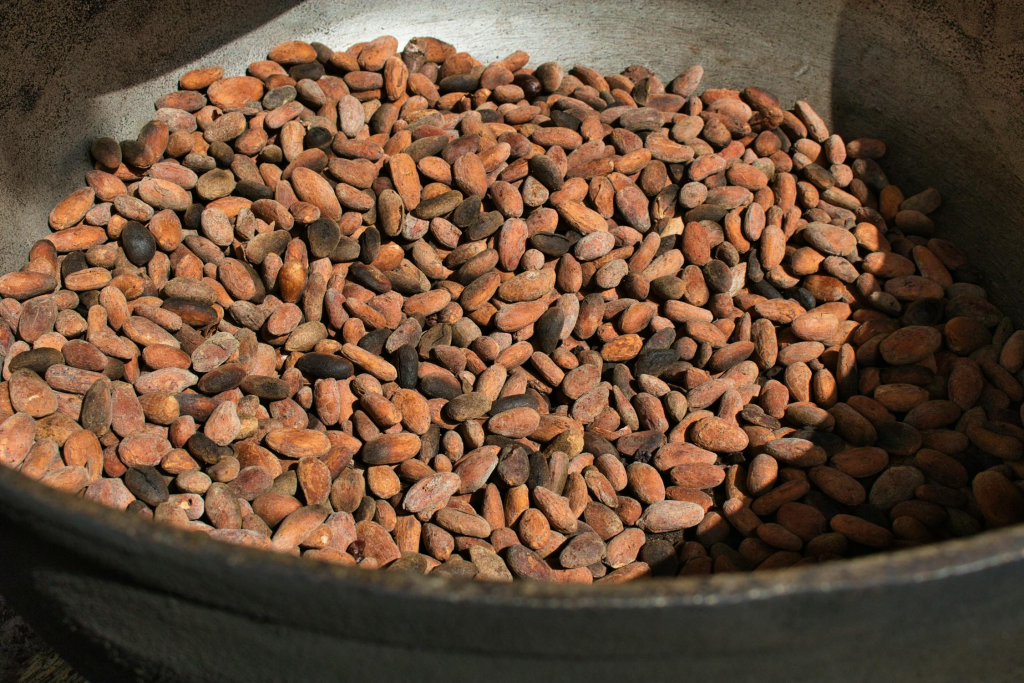Ceremonial cacao is often marketed as a premium product, but how can you differentiate it from regular cacao? It’s not always straightforward, but there are several key factors to look out for when determining if cacao is a ceremonial grade with its cacao spiritual meaning.

Below, we outline the most important tips and indicators to help you identify whether the cacao you’re purchasing is of ceremonial quality.
1. Check The Sourcing And Bean Quality
The first step in determining if cacao is ceremonial grade is to consider where it comes from and the quality of the beans.
Single-Origin And High-Quality Beans
- Single-Origin: Ceremonial grade cacao typically comes from a specific region or farm. This means it’s carefully sourced from areas known for producing high-quality cacao. Look for cacao that’s labelled as “single-origin” or from specific regions like Guatemala, Ecuador, or Peru.
- Premium Beans: Ceremonial cacao is made from the finest cacao beans, usually of the Criollo variety, known for its smooth, rich flavour and complex aromatic profile. The beans are often hand-harvested and sorted for the highest quality.
Ethical Sourcing
- Fair Trade or Direct Trade: Ensure the cacao is ethically sourced, often marked with certifications like “Fair Trade” or “Direct Trade”. This ensures farmers are paid fairly for their work and that the environment is respected.
- Organic: Many ceremonial cacao suppliers opt for organic farming practices, avoiding pesticides and chemicals, which preserve the cacao’s natural properties and contribute to the spirit of the ceremony.
2. Examine The Processing Method
Ceremonial grade cacao is processed in a way that preserves its nutritional and energetic qualities. Pay attention to how the cacao has been treated after harvesting.
Low-Heat Processing
- Minimal Heat: Traditional processing methods for ceremonial cacao involve minimal heat to ensure that the antioxidants, theobromine, and other beneficial compounds are retained. Cacao that has been roasted at high temperatures loses much of its health benefits.
- Fermentation: The cacao beans are often fermented in small batches. This enhances their flavour and helps maintain the quality of the product.
Handcrafted And Artisan Methods
- Handmade: Ceremonial cacao is often handcrafted by small artisans or traditional producers. This can include grinding the beans by hand or using stone mills, which helps preserve the integrity of the cacao and ensures the end product is smooth and creamy.
- No Additives: Unlike commercial chocolate, ceremonial cacao typically doesn’t contain additives like sugar, milk powder, or emulsifiers. It should be pure cacao paste or raw cacao, providing a more authentic and health-focused experience.
3. Consider The Texture And Appearance
When you purchase ceremonial cacao, take note of its appearance and feel. The texture and colour can tell you a lot about the quality and whether it’s truly ceremonial grade.
Smooth And Creamy Texture
- Smooth Consistency: Ceremonial cacao should have a smooth, creamy texture when melted. It should not be gritty or chunky, as that indicates poor processing or lower-quality beans.
- Meltability: High-quality ceremonial cacao melts easily at a low temperature, releasing its oils and flavours without separation or clumping.
Rich, Dark Colour
- Deep Brown Shade: The cacao should have a rich, dark brown colour, indicating it is pure and minimally processed. The colour may vary slightly depending on the region and the specific cacao bean variety, but it should not be pale or overly light.
- No Bitter Residue: When you taste ceremonial cacao, there should be no lingering bitterness or astringency. It should have a well-rounded, smooth flavour with mild natural sweetness.
4. Look For Intentionality And Spirit
Ceremonial cacao is often used in sacred rituals or ceremonies. The way the cacao is marketed, and the energy behind the product can also provide clues about whether it’s truly ceremonial grade.
Product Intent
- Ceremonial Purpose: Cacao marketed as “ceremonial grade” should be specifically intended for spiritual or ceremonial use. It should carry an invitation to use it with intention, often suggested for activities like meditation, heart-opening ceremonies, or collective rituals.
- Cultural Significance: Ceremonial cacao is tied to indigenous cultural practices and should ideally come with information about its traditional uses. Authentic ceremonial cacao often has a story or explanation about how it’s used in the context of rituals and ceremonies.
Connection To Nature
- Spirit of the Cacao: Many producers of ceremonial cacao encourage a deeper connection to the plant and its spirit. Look for suppliers who provide guidance on how to honour the cacao and use it with reverence.
- Purposeful Preparation: Some suppliers may include instructions for how to prepare and consume ceremonial cacao, emphasising mindfulness and intention during the process.
5. Confirm The Presence Of High-Quality Ingredients
Ceremonial cacao should be pure and minimally processed. In some cases, it may be blended with other natural ingredients, but it should still maintain the integrity of the cacao’s health benefits.
No Additives
- Pure Cacao: The best ceremonial cacao is free from artificial sweeteners, preservatives, and flavourings. It should be as close to raw cacao as possible, with nothing added that could detract from its natural energy and flavour.
- Natural Sweeteners (Optional): If the cacao is sweetened, it should only contain natural sweeteners such as maple syrup, coconut sugar, or honey, and these should be clearly listed in the ingredients.
Packaging And Labelling
- Transparent Labelling: High-quality ceremonial cacao will have clear, honest labelling. Look for detailed information about the sourcing, processing methods, and ingredients. Reputable suppliers will include this information to help you make an informed choice.
- Sustainable Packaging: Ethical producers often use sustainable packaging, such as biodegradable or recyclable materials, to further align with the values of ceremony and respect for nature.
6. Price Point
While not always a definitive indicator, the price of cacao can give you some insight into its quality.
Premium Pricing
- Higher Price Range: Ceremonial cacao is typically more expensive than regular cacao due to the higher quality of the beans, the artisanal processing, and the ethical sourcing practices. If the cacao is priced unusually low, it may not be ceremonial grade.
- Value for Money: While ceremonial cacao may cost more, the price reflects the energy, time, and labour that go into its production. It’s also more likely to contain higher concentrations of beneficial compounds like antioxidants, magnesium, and theobromine.
7. Testimonials And Reviews
Finally, if you’re still unsure whether the cacao is ceremonial grade, check for reviews and testimonials from other customers.
Community Feedback
- Customer Testimonials: Look for reviews from other buyers who have used the cacao in ceremonial or spiritual settings. Positive feedback regarding the cacao’s quality, flavour, and ceremonial use is a good sign.
- Word of Mouth: Many communities, both online and in person, discuss their experiences with different cacao suppliers. If a supplier is highly regarded within these circles, it’s likely they offer a true ceremonial grade product.
Conclusion
By considering these key factors—sourcing, processing methods, appearance, intentionality, and pricing—you can confidently identify whether the cacao you’re purchasing is of ceremonial grade.
Choosing high-quality ceremonial cacao ensures you’re getting the most authentic and healthful experience, whether you’re using it for meditation, ceremonies, or simply enjoying its rich flavour.
Frequently Asked Questions
How Can I Tell If My Cacao Is Ceremonial Grade?
To determine if your cacao is ceremonial grade, check for the quality of the beans, the processing method (it should be minimally processed and low-heat), and the sourcing (look for organic and ethically sourced options). Additionally, ceremonial cacao is typically single-origin and has a smooth, rich texture.
Is Ceremonial Cacao Safe To Consume Regularly?
Yes, ceremonial cacao is generally safe to consume regularly, especially if you enjoy the benefits it provides. However, as it contains caffeine-like compounds such as theobromine, it’s best to consume it in moderation, particularly if you’re sensitive to stimulants.
Can I Use Ceremonial Cacao For Baking Or Making Chocolate?
Ceremonial cacao can technically be used in baking or for making chocolate, but it’s best enjoyed in its traditional form to preserve its ceremonial and health benefits. If you’re looking for cacao to bake with, it’s better to use regular cacao powder or nibs.
